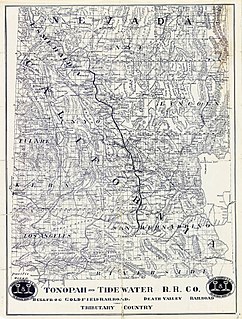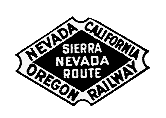 | |
| Locale | Battle Mountain, Nevada to Barstow, California, with branch line to Reno, Nevada via Tonopah, Nevada |
|---|---|
| Predecessor | |
| Track gauge | 4 ft 8 1⁄2 in (1,435 mm) standard gauge |
The Mid-Pacific Railroad was an idea proposed by a Andrew Stevenson in 1929 to build and operate a 1,000-mile-long north-to-south railroad through central and eastern Nevada and southern California. [1]
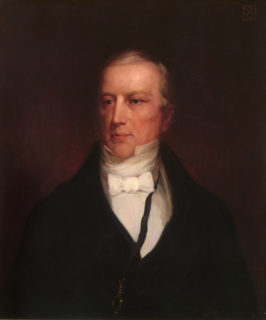
Andrew Stevenson was a Democratic politician in the United States. He served in the United States House of Representatives representing Virginia, as Speaker of the House, and as Minister to the United Kingdom.
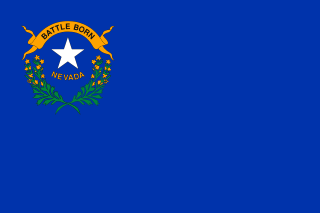
Nevada is a state in the Western United States. It is bordered by Oregon to the northwest, Idaho to the northeast, California to the west, Arizona to the southeast, and Utah to the east. Nevada is the 7th most extensive, the 32nd most populous, but the 9th least densely populated of the U.S. states. Nearly three-quarters of Nevada's people live in Clark County, which contains the Las Vegas–Paradise metropolitan area where three of the state's four largest incorporated cities are located. Nevada's capital is Carson City.

California is a state in the Pacific Region of the United States. With 39.6 million residents across a total area of about 163,696 square miles (423,970 km2), California is the most populous U.S. state and the third-largest by area. The state capital is Sacramento. The Greater Los Angeles Area and the San Francisco Bay Area are the nation's second- and fifth-most populous urban regions, with 18.7 million and 9.7 million residents respectively. Los Angeles is California's most populous city, and the country's second-most populous, after New York City. California also has the nation's most populous county, Los Angeles County, and its largest county by area, San Bernardino County. The City and County of San Francisco is both the country's second-most densely populated major city after New York City and the fifth-most densely populated county, behind only four of the five New York City boroughs.
Had it been built, the railroad would have run from Battle Mountain, Nevada to Barstow, California with a branch line to Reno, Nevada via Tonopah, Nevada, over parts of track belonging to the Atchison, Topeka and Santa Fe Railroad, Southern Pacific Railroad and the Union Pacific Railroad, and over the routes of several shortline and narrow gauge railroads located within Southern California and Nevada, including the Tonopah and Tidewater Railroad, Bullfrog Goldfield Railroad, Las Vegas and Tonopah Railroad, Tonopah and Goldfield Railroad, Nevada Central Railroad, Virginia and Truckee Railroad, Eureka and Palisade Railroad, and the Nevada Copper Belt Railroad, with new railroads built in between to stitch these lines together. It would have cost an average of $10,658,000 to build.

Battle Mountain is an unincorporated town in and the county seat of Lander County, Nevada, United States. The population was 3,635 at the 2010 census. Its primary economic base is gold mining and to a lesser extent, legalized gaming.

Barstow is a city in San Bernardino County, California, United States. The population was 22,639 at the 2010 census. Barstow is located 67 miles (108 km) north of San Bernardino.
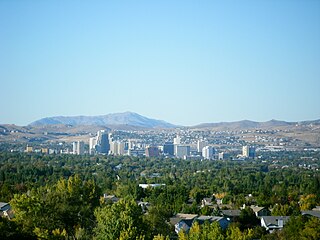
Reno is a city in the northwest section of the U.S. state of Nevada, approximately 22 miles (35 km) from Lake Tahoe, known as "The Biggest Little City in the World".
The plan was put forward in 1932 to a group of men in the Nevada Manhattan Corporation and the railroads involved, described as a way to "bring the Great Northern into Los Angeles." Several of the railroad companies involved expressed interest in the plan, but the project was never completed due to the combined effects of the Great Depression, the abandonment of the gold standard by the United States and Great Britain in 1932, and Stevenson's death in 1933.

The Great Northern Railway was an American Class I railroad. Running from Saint Paul, Minnesota, to Seattle, Washington, it was the creation of 19th-century railroad entrepreneur James J. Hill and was developed from the Saint Paul & Pacific Railroad. The Great Northern's (GN) route was the northernmost transcontinental railroad route in the U.S.

The Great Depression was a severe worldwide economic depression that took place mostly during the 1930s, beginning in the United States. The timing of the Great Depression varied across nations; in most countries, it started in 1929 and lasted until the late 1930s. It was the longest, deepest, and most widespread depression of the 20th century. In the 21st century, the Great Depression is commonly used as an example of how intensely the world's economy can decline.

A gold standard is a monetary system in which the standard economic unit of account is based on a fixed quantity of gold. The gold standard was widely used in the 19th and early part of the 20th century. Most nations abandoned the gold standard as the basis of their monetary systems at some point in the 20th century, although many still hold substantial gold reserves. In a 2012 survey of leading economists, they unanimously opined that a return to the gold standard would not benefit the average American.



